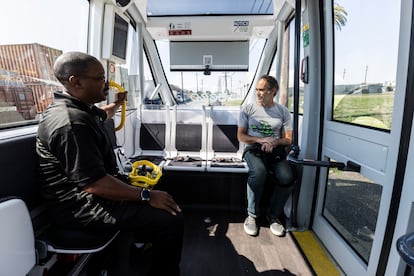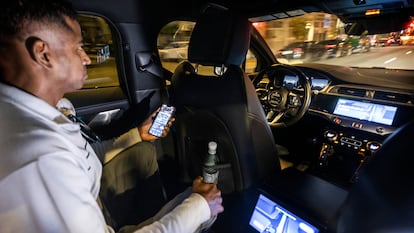Robotaxis: Taking a ride in a self-driving car through downtown San Francisco
The city has become the battlefront for technology companies vying to control the future of urban mobility amid concerns about the safety of driverless vehicles

It’s 7:00 p.m. in San Francisco’s Mission District. Elango, 52, born in India but Californian by adoption, is about to take his first Waymo self-driving car. Barely three minutes after making the request through the app the vehicle appears: it is a Jaguar surrounded by sensors. Tapping a button on his phone, he unlocks the door, from which a handle comes out. As he enters, relaxing music plays. A female voice welcomes him and asks him to buckle up. The driver’s seat — empty, of course — is pushed all the way forward for his comfort. A screen in the middle of the cabin lets him press a button to begin his futuristic journey.
The vehicle he is riding is known as robotaxi; a driverless, electric vehicle full of sensors and cameras. At the moment, they only move around the most central districts of San Francisco, and never on highways. This California city has become the front line for Silicon Valley’s big technology companies’ effort to control the future of urban mobility.
“I’m so nervous. It’s like the first time I got on a plane. I feel like a kid in a candy store,” Elango says. He seems particularly impressed by the steering wheel moving on its own at the first intersection. “It’s fascinating,” he says, excited. On the three rides he has taken this afternoon (about 15 minutes each), the driving has been smooth; just a little hard brake has altered the peace of the journey, when another car crossed in front.
On average, each trip has cost about $15, and the top speed was 30 miles per hour. “I felt very safe at all times. It’s impressive how the car yielded to pedestrians and looked for the most appropriate place to stop,” he says. The only mistake occurred at the end of the final trip, when the vehicle came to a stop 300 feet from the requested destination..

At the moment, the two main companies in the robotaxi business are Waymo and Cruise. Waymo is owned by Alphabet (Google’s parent company) and its vehicles have a more upscale appearance. Its fleet has 250 modified Jaguar I-Pace cars. Cruise belongs to several companies, including General Motors and Microsoft. The Chevy Bolt cars it uses are smaller and have been in operation for less time. Although they have already been authorized to extend their hours, at the moment they only carry users after 9:00 p.m. They have 300 vehicles.
The technology is already available to thousands of users, but there is a waiting list of several months to download the app. Up until the first week of August both platforms were free to use, but after the State of California announced that driverless cabs were allowed to operate 24/7, they started to charge.
Collisions on the road
Waymo communications manager Julia Ilina explains that, since they began operating with users in December, the collisions that have occurred have always been due to human errors from other vehicles. “The safety performance data of our first million miles shows that there have been no injuries or collisions with pedestrians or cyclists. The recorded incidents have always been due to errors on the part of human drivers.”
The Waymo driver, she explains, is much safer than a human for several reasons: “It is equipped with a series of sensors that give it 360-degree peripheral vision day and night, up to three football fields away. Our driver is designed to respect the rules and it does not get distracted, drunk or tired.” Waymo has announced expansion plans in Los Angeles and Austin.
With the arrival of Cruise, the second platform that offers driverless taxi services, the number of these machines doubled. Accidents have also increased, and protest movements against this technology have emerged. The activist group Safe Street Rebel monitors all traffic incidents generated by these autonomous vehicles on its website, and it has launched a campaign to encourage people to place traffic cones on the hoods of the cars in order to disable them.
On August 17, a fire truck responding to an emergency collided with a Cruise robotaxi at an intersection. According to a company statement, the vehicle proceeded through the intersection because the light was green. San Francisco Fire Chief Jeanine Nicholson says that more than 60 driverless cars have interfered with fire trucks since May last year, and complains that these vehicles hinder their work when human lives are at risk. “Our people cannot be paying attention to an autonomous vehicle when we have to raise ladders. I am not against technology; I am in favor of security,” she declared last week.
As a result of the latest incidents, the California Department of Motor Vehicles asked General Motors to halve its operating cars in the city. On August 11, 10 vehicles belonging to this company stopped moving, causing a major traffic jam in North Beach. According to GM, this happened because the 5G network went down due to the massive influx of people attending a music festival.
Tobías, 35, gets in a Cruise robotaxi at the door of his home in the central Fillmore District. This Portuguese man has been using the app since April. He acknowledges that these cars are not yet ready to drive at rush hour, but he takes it as something normal, part of the process. “They are still learning. I think that in the future it will be safer than human driving,” he says. However, he has seen some changes in the last few months. “I have noticed that now they drive somewhat more aggressively. At the beginning they were too slow; that was also a problem.”
During the ride, the car goes around certain areas for no apparent reason. “The route is not optimal at all; it clearly avoids areas that for some reason it doesn’t want to cross. A 10-minute journey can take 15 minutes. Also, sometimes there is a message on the screen saying that someone is taking control of the car remotely.” Another thing that worries Tobías is that he feels watched. “There are cameras and microphones that are always on, and sometimes a person will talk to you, ask if everything is going well.”
The Taxi Workers Alliance has also expressed concern about the danger that competition from this technology poses to their future, and called a protest before the State of California legislated in favor of these services. “Taxi drivers are the canaries in the coal mine in the future onslaught of artificial intelligence,” said Mark Gruberg, a member of the union’s executive board.
Gulshan has been an UBER driver for eight years. It is 10:00 p.m. and he still has a few hours left to finish his shift behind the wheel of his shiny white Tesla. He has come to terms with the imminent arrival of artificial intelligence behind the wheel. “I used to be a taxi driver, and I made more money. When the platforms arrived I decided to change. Now there’s this… I think resisting technology is pointless,” he reflects. However, he does not see a close threat yet, because “those cars are very expensive, and I don’t think they can interpret situations, especially in exceptional circumstances, as we do.”

A pilot project with buses
In another area of the city, far from the center, in Treasure Island, a pilot project with autonomous buses from the company Beep is being carried out. However, these small vehicles with seating capacity for 11 passengers still require someone on board to supervise them. Marvin Saucer, an operator who previously worked testing cars at Tesla and GM Cruise, awaits travelers on board. He holds a controller with two levers to take over if something goes wrong. “I receive people, make sure they buckle up.” He also does public relations. “I am a sociable person, I like talking to people,” he says.
The bus travels about three miles with seven stops in an area with no traffic lights and hardly any traffic. The complete service, which is free, takes 15 minutes. Eric Young, a spokesman for the agency that manages mobility on Treasure Island, says that they are working to get a second Beep shuttle. “The idea is to better understand how this innovation could meet the needs of our residents and give them the chance to learn about driverless technology.” Beep already has two similar shuttles operating 30 miles from Treasure Island, in San Ramón. Just like the robotaxis, robotic buses are also a reality in San Francisco.
Sign up for our weekly newsletter to get more English-language news coverage from EL PAÍS USA Edition
Tu suscripción se está usando en otro dispositivo
¿Quieres añadir otro usuario a tu suscripción?
Si continúas leyendo en este dispositivo, no se podrá leer en el otro.
FlechaTu suscripción se está usando en otro dispositivo y solo puedes acceder a EL PAÍS desde un dispositivo a la vez.
Si quieres compartir tu cuenta, cambia tu suscripción a la modalidad Premium, así podrás añadir otro usuario. Cada uno accederá con su propia cuenta de email, lo que os permitirá personalizar vuestra experiencia en EL PAÍS.
¿Tienes una suscripción de empresa? Accede aquí para contratar más cuentas.
En el caso de no saber quién está usando tu cuenta, te recomendamos cambiar tu contraseña aquí.
Si decides continuar compartiendo tu cuenta, este mensaje se mostrará en tu dispositivo y en el de la otra persona que está usando tu cuenta de forma indefinida, afectando a tu experiencia de lectura. Puedes consultar aquí los términos y condiciones de la suscripción digital.











































